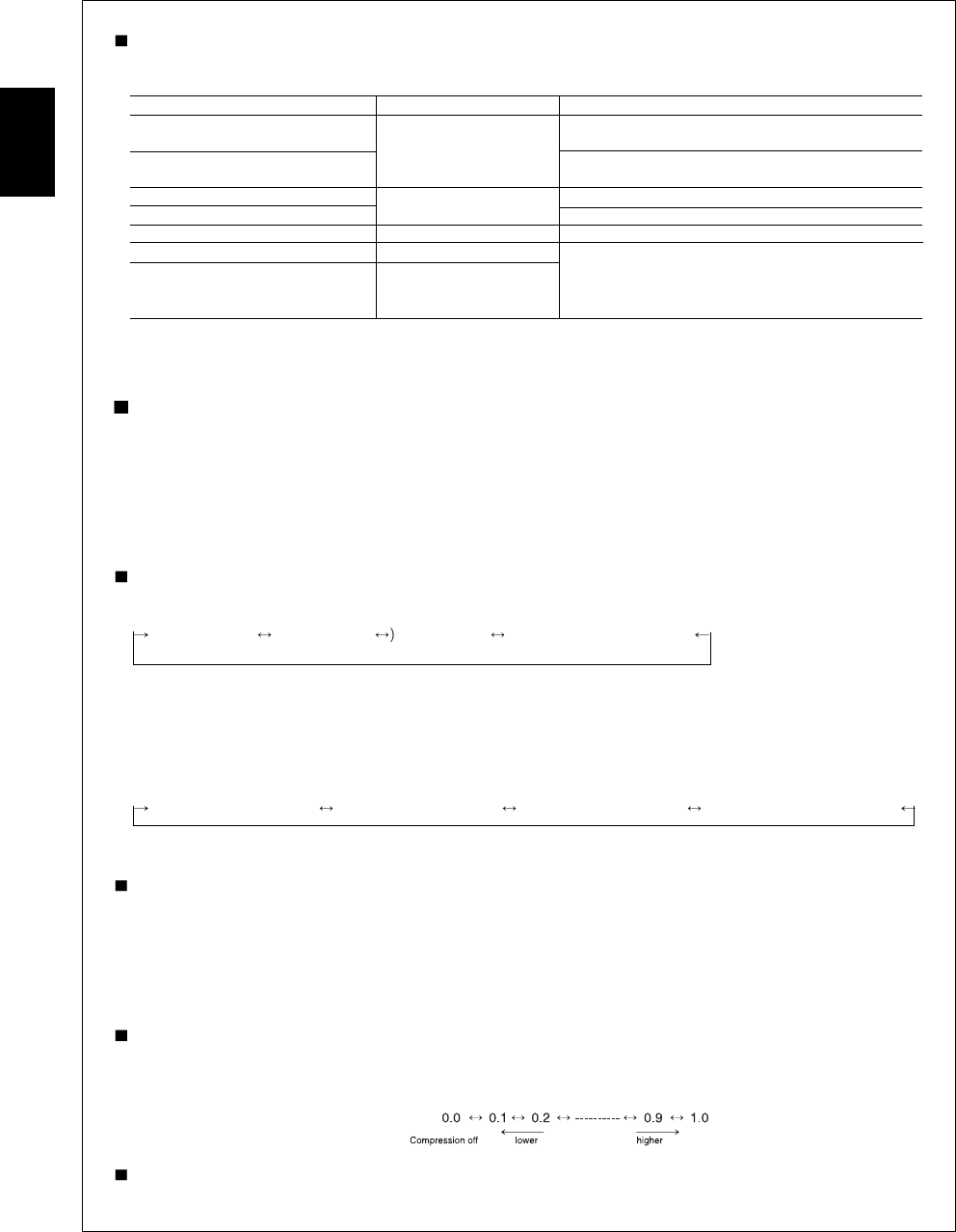
ENGLISH
61
When the SURROUND MODE is selected
• Depending on the input signal format and the selected decoding mode, you can select the desired surround mode as
follows:
Signal format being input Selected decoding mode Selectable surround mode
Dolby Digital 5.1, Auto, Dolby Digital mode (DOLBY DIGITAL EX,)
Dolby Digital EX 6.1 channel sources DOLBY DIGITAL
Dolby Digital 2 channel sources (DOLBY DIGITAL EX,) DOLBY DIGITAL, PL II MOVIE,
PL II MUSIC
DTS sources Auto, DTS mode (DTS ES MATRIX or DTS ES DISCRETE,) DTS
DTS 96/24 sources DTS 96/24
MPEG sources Auto, MPEG mode MPEG
PCM ( 2 channel ) sources Auto, PCM mode PL II MOVIE, PL II MUSIC, BYPASS,
Analog stereo sources
-
DTS NEO 6 : CINEMA, DTS NEO 6 : MUSIC, THEATER,
MOVIE, HALL 1/2, STADIUM, CHURCH, CLUB 1/2,
ARENA 1/2, GAME, 4CH STEREO, MATRIX
( ): Possible only when surround back channel is not set to “None”.(Refer to “When selecting the SPEAKER CONFIGURATION” on page 45.)
BYPASS mode: Audio signals bypass signal processing circuits for surround sound and are played in stereo mode.
If Dolby Pro Logic IIx, Dolby Virtual Speaker or Dolby Headphone mode is combined with BYPASS mode, you will enjoy
its original surround effects, not affected by other surround modes.
Notes:
• When the selected decoding mode is not matched to the input signal format, the indicator of the signal being input flickers,
meaning the required process cannot be performed and no sound is heard. Therefore, be sure to select the required
decoding mode and the available surround mode according to the input signal format.
• When the pure audio function is activated, the surround mode cannot be selected.
• When 96 kHz PCM signals are input, only the stereo mode can be selected.
• When DTS 96/24 or MPEG signals are input, the Dolby Pro Logic IIx, Dolby Virtual Speaker and Dolby Headphone modes
cannot be selected.
When thez Dolby surround mode is selected
* In case that the HEADPHONE SELECTOR button is set to speaker on mode.
• Combined with the original surround mode, the Dolby surround mode can be selected as follows:
(PL IIx MOVIE PL IIx MUSIC DOLBY VS~ NONE(Dolby surround off)
(original surround mode)
( ) : Impossible only when the power amplifier for the surround back channels is assigned to the “ROOM2” or surround back channel
is set to “None”.
• In case of playing in the stereo or 2CH downmix mode, it is canceled and the selected “PL IIx” or “DOLBY VS” mode
will be combined with the previous mode.
* In case that the HEADPHONE SELECTOR button is set to speaker off mode.
• Combined with the current mode, the Dolby Headphone mode can be selected as follows:
DOLBY HEADPHONE 1 DOLBY HEADPHONE 2 DOLBY HEADPHONE 3 NONE(Dolby Headphone off)
• If you select the Dolby Headphone off mode, either the stereo mode or the 2 CH downmix mode will be selected
depending on the signal format which is being input.
Notes :
• In case of that the original surround mode is “DOLBY DIGITAL EX” or “DTS ES” mode, it will be automatically changed
to “DOLBY DIGITAL” or “DTS” mode.
• Only when playing a stereo(2 channel) source in “PL IIx”, “DOLBY VS” or “DOLBY HEADPHONE” mode, you can
select the original surround mode to be combined.(However, in case of “PL IIx” mode, you cannot select “PL II”mode.)
• When “PL IIx” mode is selected while playing in “PL II” mode, it will be automatically changed to “DOLBY DIGITAL”
or “BYPASS” mode depending on the signal format which is being input.
When the DYNAMIC RANGE is selected
• This function compresses the dynamic range of previously specified parts of the Dolby Digital sound track (with extremely
high volume) to minimize the difference in volume between the specified and non-specified parts.
This makes it easy to hear all of the sound track when watching movies at night at low levels.
• The compression rate changes as follows :
Notes :
• Only while the digital signals from the Dolby Digital program source are being input, the dynamic range function can be activated.
• In some Dolby Digital software, this function may not be available.


















